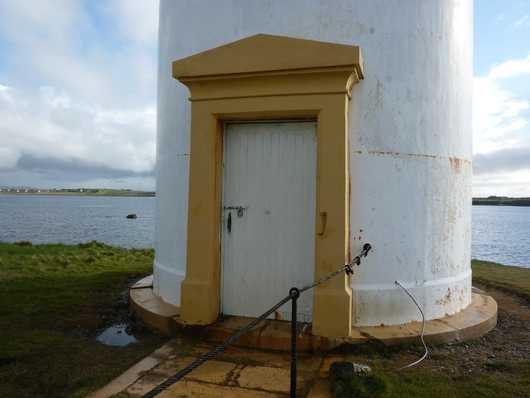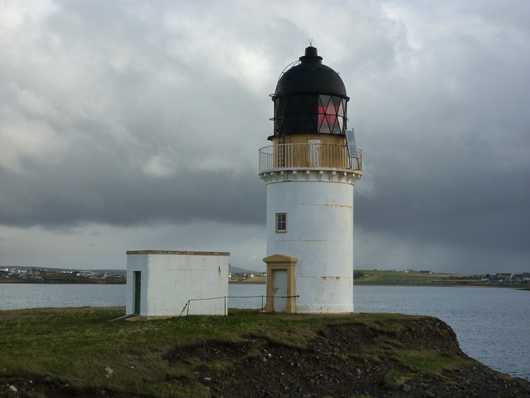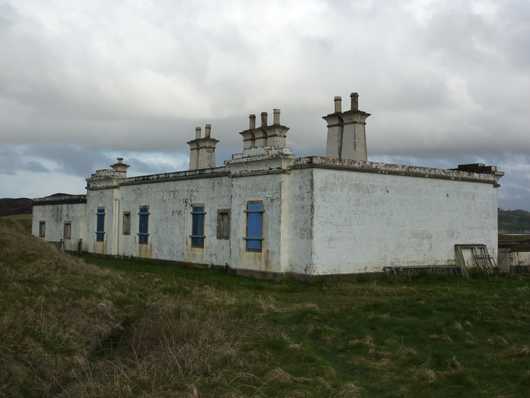Arnish Point

Arriving in Stornaway by boat one of the first structures you may notice from the port side of a vessel is the small iron lighthouse on Arnish Point, on the western side of Stornoway Bay.
Located accross the bay from Stornoway itself, the site was not accessible by land until much more recently, as it is seperated from the town by several miles of rough and boggy moorland, which meant that getting large quantities of stone and other construction materials to the site for a more tradional lighthouse would have been probitively expensive and time consuming; as such four tenders were sought to build an prefabricated iron tower, and each submitted a bid, with figures ranging from £235 to £420, whilst only one tender could be found for the construction of a more traditional masonry tower, at a cost of £513. On grounds of cost and practicality the construction of an iron tower to be fabricated off-site and assembled on the peninsular was chosen, coming to fruition in 1852.
The tower was built to plans drawn-up by Alan Stevenson. Struck with paralysis later that same year, Alan Stevenson went on to resign the post of Engineer to the Commissioners of Northern Lighthouses in 1853, making Arnish Point the last of his 13 lighthouses. When the tower was completed and lit in 1852 it is reported that it exhibited a flash every 30 seconds visible for 12 Nautical Miles.
The tower was constructed from curved metal plates that were bolted together, and the interior was lined with wood paneling. At the tower's lowest level there is an ornate doorway on the landward-facing side to access the tower, and there is a square window that points seawards. Further up the structure are decorative iron details that resembel corbels that are often used to support the gallery in more traditional masonry lighthouses. The lantern itself is of a fairly standard NLB design, utilising flat panes of tesselated trianular glass to create a circular lantern room. Access to the gallery is via a wooden door in the watchroom.
Nearby is a single storey dwelling for the lighthouse keepers, constructed from stone in an egyptian influenced style incorporating Cavettos above the doors and windows, as well as tapered chimneys with similar overhangs, a staple that Alan Stevenson had adopted circa 1846 when designing the lighthouse at Covesea Skerries. Seperate from the accomodation are a set of small walled gardens with outbuildings so that the keepers could grow food.
At the same time as the lighthouse was constructed, a nearby rock was also marked with the construction of a black conical stone tower that stood 9 metres in height, which supported a glass prism. A projector was shone at this prism from the square window at the base of the lighthouse, resulting in an illusion that made it appear as if the light was being produced by the prism itself. Local fishermen at the time commented on this marker, claiming "The deception is so perfect that we cannot believe a light is not there". The rock became known as beacon rock, although the cone with the prism was toppled by a storm in 1973 and was later replaced by a buoy. Today a a small portion of the toppled structure can be seen offshore and the window in the base of the lighthouse from which the projector shone still exists.
The light was automated in 1963, and converted from gas to an electric light powered by solar power in 2000. The Light now gives the character of 1 flash every 15 seconds, visible for 21 Nautical Miles.
To reach the lighthouse, follow the A859 out of Stornoway and follow signs to Arnish Industrial Estate - you can drive up to the old keepers houses which are now privately owned, having been sold off by the NLB upon automation of the light.


.jpg)






